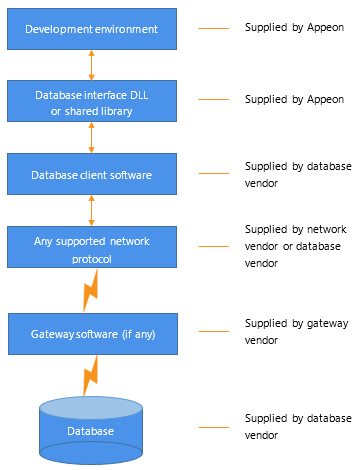The native database interfaces provide native connections to many databases and DBMSs. This section describes how the native database interfaces access these databases.
For a complete list of the supported native database interfaces, see "Supported Database Interfaces" in online Help.
A native database interface is a direct connection to your data in InfoMaker.
Each native database interface uses its own interface DLL to communicate with a specified database through a vendor-specific database API. For example, the Adaptive Server interface uses a DLL named PBSYC.dll to access the database, while the Oracle database interface accesses the database through PBO10.dll (Oracle 10g) and PBORA.dll (Oracle 12c/18c/19c/21c/23c).
In contrast, a standard database interface uses a standard API to communicate with the database. For example, InfoMaker can use a single-interface DLL (PBODB.dll) to communicate with the ODBC Driver Manager and corresponding driver to access any ODBC data source.
When you use a native database interface to access a database, your connection goes through several layers before reaching the data. Each layer is a separate component of the connection and each component might come from a different vendor.
Figure: Components of a database connection

For diagrams showing the specific components of your connection, see "Basic software components" in the section in this chapter for your native database interface.
You perform several basic steps to use a native database interface to access a database.
About preparing to use the database
The first step in connecting to a database through a native database interface is to prepare to use the database. Preparing the database ensures that you will be able to access and use your data in InfoMaker.
You must prepare the database outside InfoMaker before you start the product, then define the database interface and connect to it. The requirements differ for each database -- but in general, preparing a database involves four basic steps.
To prepare to use your database with InfoMaker:
-
Make sure the required database server software is properly installed and configured at your site.
-
If network software is required, make sure it is properly installed and configured at your site and on the client computer so that you can connect to the database server.
-
Make sure the required database client software is properly installed and configured on the client computer. (Typically, the client computer is the one running InfoMaker.)
You must obtain the client software from your database vendor and make sure that the version you install supports all of the following:
The operating system running on the client computer
The version of the database that you want to access
The version of InfoMaker that you are running
-
Verify that you can connect to the server and database you want to access outside InfoMaker.
For specific instructions to use with your database, see "Preparing to use the database" in the section in this chapter for your native database interface.
About installing native database interfaces
After you prepare to use the database, you must install the native database interface that accesses the database. See the instructions for each interface for more information.
About defining native database interfaces
Once you are ready to access the database, you start InfoMaker and define the database interface. To define a database interface, you must create a database profile by completing the Database Profile Setup dialog box for that interface.
For general instructions, see About creating database profiles. For instructions about defining database interface parameters unique to a particular database, see "Preparing to use the database" in the section in this chapter for your database interface.


